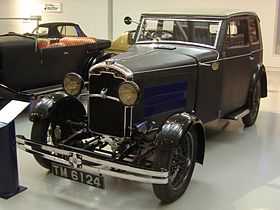Rover Light Six
| Rover Light Six | |
|---|---|
 | |
| Overview | |
| Manufacturer | Rover |
| Production |
1927–1932 approx 8000 made.[1] |
| Body and chassis | |
| Class | Midsize car |
| Body style | Saloon |
| Powertrain | |
| Engine | 2 L (2023 cc) straight-6 |
| Transmission | three speed manual |
| Dimensions | |
| Wheelbase | 96 in (2,438 mm)[2] |
| Length | 178 in (4,521 mm)[2] |
| Width | 63 in (1,600 mm)[2] |
The Rover Light Six was a mid-size formal saloon produced from 1927 through to 1932 by the Rover Company of Coventry.
Overview
The Rover Light Six was one of the first Rover cars manufactured under the aegis of Spencer and Maurice Wilks who introduced new management practices and engineering techniques to Rover.
It was powered by a watercooled 2 L straight-6 OHV engine with an output of 45 bhp at 3600 rpm [2] designed by Peter Poppe, which allowed a maximum speed of 60 mph (97 km/h). The bore of 65 mm put the engine into the 16 hp taxation class. The suspension was conventional for the time with half elliptic leaf springs all round. It was available with a two-door "Sportsman's Saloon" bodywork by Weymann, a regular coachbuilder for Rover cars at that time. The 'Standard' version came at a price of 325 Pound Sterling, while the luxurious 'Regal' edition cost 355 Pound Sterling. A four-door version became available during the last two years of production for 335 Pound Sterling, also supplied by Weymann.
The Rover Light Six gained a worldwide reputation when it was the first successful participant in the Blue Train Races, a series of record-breaking attempts between automobiles and trains in the late 1920s and early 1930s. It saw a number of motorists and their own or sponsored automobiles race against the Le Train Bleu, a train that ran between Calais and the French Riviera.
Blue Train Race
In January 1930, the Rover name hit the world press when a Rover tried to take on "Le train bleu" on its 750 mile run between Calais and Cannes. The idea of racing the Blue Train was very popular with motor enthusiasts, and each new attempt was received with varying expectations of success. Many had already failed on this mammoth challenge. The act to promote the new Rover Light Six in a headline-grabbing campaign was the brainchild of former motorcycle tester and pioneer publicist Dudley Noble, in which a Light Six was to race the Blue Train across France from Calais to St Raphael on the Côte d'Azur. It was a moderately shameless stunt of him, being safe in the knowledge that the average speed of the famous express was no more than about 40 mph once all its stops and detours were taken into account. To beat the train, Noble had to drive more or less non-stop from Calais to the French Riviera. The Rover Light Six averaged 38 mph on its 750 miles journey to beat the train's expected time of just over 20 hours, which gave the Rover team a 20 minute lead over the train. It had been beaten for the first time and the Rover team became celebrities through the "Daily Express".[3][4][5][6][7]
In March 1930, Bentley Boy Woolf Barnato raised the stakes on Rover by bettering the record with his 6½ Litre Bentley Speed Six on a bet of 100 Pound Sterling. He drove against the train from Cannes to Calais, then by ferry to Dover and finally London, travelling on public highways, and won; the H. J. Mulliner-bodied formal saloon he drove during the race as well as a streamlined fastback "Sportsman Coupé" by Gurney Nutting he took delivery of on 21 May 1930 became known as the Blue Train Bentleys; the latter is regularly mistaken for or errouneously referred to as being the car that raced the Blue Train, while in fact Barnato named it in memory of his race.[8][9]
References
- ↑ Baldwin, N. (1994). A-Z of Cars of the 1920s. Devon, UK: Bay View Books. ISBN 1-870979-53-2.
- ↑ 2.0 2.1 2.2 2.3 Culshaw; Horrobin (1974). Complete Catalogue of British Cars. London: Macmillan. ISBN 0-333-16689-2.
- ↑ Graham Robson (1981). The Rover company (2 ed.). Patrick Stephens. ISBN 0-85059-543-6.
- ↑ Chris Brady & Andrew Lorenz (2005). End of the Road: The Real Story of the Downfall of Rover. Prentice Hall. ISBN 0-273-70653-5.
- ↑ Lewis, Robert (2003-07-11). "Five Million Rovers (And More)". Car Keys. Retrieved 2008-11-04.
- ↑ "Rover Report on their first 70 years". British Motor Heritage Centre. 1974-07-26. Retrieved 2008-11-04.
- ↑ Pickard, J. (2004-11-16). "Reserved and Refined British Saloon Cars: Official History of Rover and Timeline Milestones". Rover 1904-2004. Retrieved 2008-11-04.
- ↑ Melissen, Wouter (2004-01-12). "Bentley Speed Six 'Blue Train Special'". UltimateCarPage. Retrieved 2008-11-04.
- ↑ Burgess-Wise, David (2006-01-01). "The Slippery Shape of Power". Auto Aficionado. Retrieved 2008-11-04.